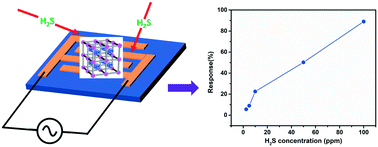A silver nanoparticle-anchored UiO-66(Zr) metal–organic framework (MOF)-based capacitive H2S gas sensor
Abstract
Hydrogen sulfide (H2S) is a highly poisonous gas; if present in a workplace, it must be identified immediately at concentrations greater than 10 ppm. Although there are numerous reports on sensing H2S gas using various techniques and approaches, there still exists a gap in terms of the limit of detection (LOD) and feasibility. In this work, we demonstrated capacitive H2S sensing for the first time using metal–organic frameworks (MOFs) decorated with silver oxide (Ag2O) nanoparticles as the sensing materials. The nanoparticles were deposited on three MOFs (UiO-66(Zr) BDC, UiO-66(Zr) BDC-NO2, and UiO-66(Zr) BDC-N3) using the impregnation technique. The sensing materials were characterized for morphology using X-ray diffraction, scanning electron microscopy, and X-ray photoelectron spectroscopy techniques. The synthesized MOFs were coated on interdigitated electrode capacitors as the dielectric materials and a comparison of their sensing properties was presented; among them, UiO-66(Zr) BDC-NO2 loaded with Ag2O showed the highest sensitivity towards H2S. The optimized MOF–Ag2O composite demonstrated experimental LOD of 1 ppm of H2S at room temperature, showing high chemical absorption affinity towards H2S. The work presented here is promising for developing sensitive H2S sensors and in addition paves the way to explore and develop other possible MOF-based composite materials for gas sensing applications.



 Please wait while we load your content...
Please wait while we load your content...